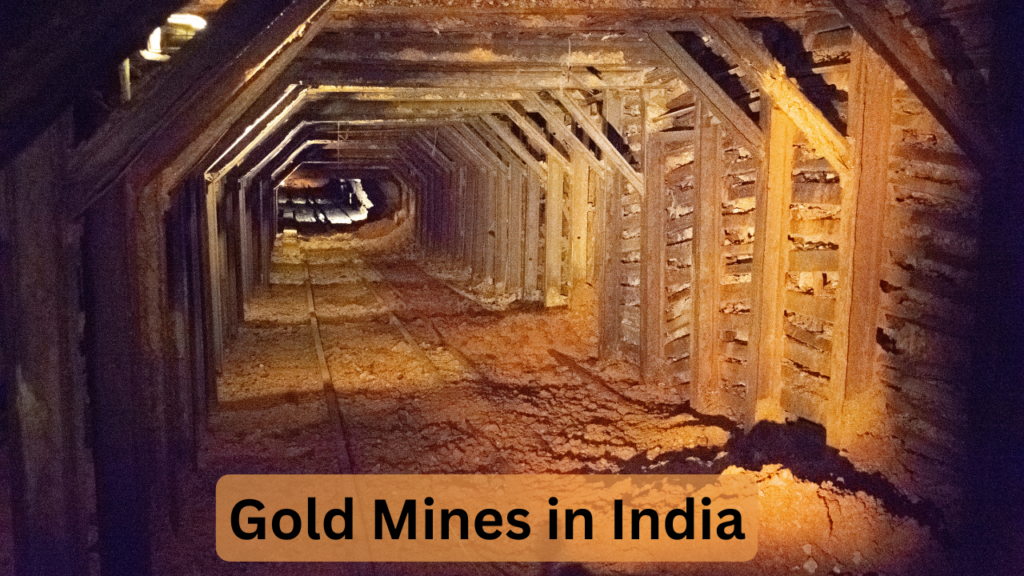Table of Contents
Gold Mines in India
Gold mines In India, have a lot of historical and cultural value.
The mining of gold dates back to ancient times, and well-known mines like Kolar, Hatti, and Sonbhadra have been in operation for centuries after their first opening.
It is believed that India has a huge gold reserve, which accounts for around 23,000–24,000 tons and is valued at over $800 billion.

Gold is deeply ingrained in Indian culture, serving as a central component in religious ceremonies, family traditions, presents, and as a signal of social standing.
This is in addition to the fact that gold is economically significant.
Women often wear gold during weddings, and temples often receive it as a symbol of auspiciousness and purity.
Different areas of India each exhibit their own distinctive styles of gold jewelry, which is a reflection of the diversity that exists within Indian culture.
Additionally, gold is an important component of the Indian economy, as it plays a part in the creation of jobs, the acquisition of foreign currency, and the maintenance of a healthy trade balance.
The gems and jewelry industry in India is one of the greatest in the world.
It accounts for around 29 percent of the total consumption of goods worldwide and employs millions of people, including artists and craftsmen.
Gold Reserve in India

This is a modest increase from the amount held in January 2024, which was USD 47.967 billion.
This update is the most recent data point in a series that has been monitoring India’s gold reserves since December 1956.
A record low of USD 175.469 million was recorded in March 1989, according to the statistics, which demonstrates tremendous increase over the course of the decades.
These numbers are provided on a monthly basis by the Reserve Bank of India, which contributes to a complete dataset that has 807 observations throughout the course of the time.
Biggest gold mine in india
The biggest gold mine in India is the Hutti Gold Mines in Karnataka.
With a history that dates to the second century AD, it is also among the oldest mining enterprises in the world. The Hutti Gold Mines in Karnataka are presently run by the government-owned Hutti Gold Mines Limited (HGML).

Hutti is renowned for its extensive scope and for having several departments that oversee various facets of the extraction and processing of ore as well as other steps in the gold mining process.
More research is required to ascertain the actual gold reserves in the Hutti region due to the amount of gold resources there.
Hutti is now the largest gold mine in India and a major player in the gold mining industry as a result.
The Historical Context of Gold Mining in India
During the time of the Harappan civilization, gold mining in India was an activity that dates back to prehistoric times.
Both historical documents and archeological data point to the fact that the southern regions of India, and Karnataka in particular, were very important for their gold mining operations.
In India, one of the most important sources of gold is the well-known Kolar Gold Fields (KGF), which closed in 2001 after having been in operation for more than a century.
The vast gold riches that were discovered in these regions may have served as the inspiration for the tale of El Dorado.
Current Gold Mining Operations in India
Although India’s gold mining industry may not be as productive as it was in the past, it still has plenty of potential in the present day. The following are the main gold mines that are presently in operation:
The Hutti Gold Mines are one of India’s few gold mines that are still operational.
The state of Karnataka is home to them. The government of Karnataka often lists Hutti as one of the high-potential locations for gold mining.
In order to increase gold output, there are plans for growth and more thorough research.
Recently, news has emerged about the discovery of a gold resource in Sonbhadra, Uttar Pradesh.
The discovery took place in Sonbhadra Mines. Initial estimations suggest that this location may have substantial gold reserves, which might possibly lead to a recovery of the gold mining industry in the region.
Challenges Facing Gold Mining in India
The gold mining operations in India face a number of challenges, despite the fact that they have a lot of potential.
Concerns about the environment Mining activities have substantial environmental implications, such as the destruction of forests, the erosion of soil, and the poisoning of water.
Environmentally sensitive mining regions must implement environmentally responsible methods and strict laws.
The mining industry suffers from technological backwardness because it does not have access to contemporary technology and infrastructure, which hinders both efficiency and production.
It is extremely important to invest in cutting-edge technology in order to revitalize India’s gold mining operations.
Regulation Issues: Stringent regulations, coupled with administrative hurdles, often slow down operations in India’s mining industry.
Improving the regulatory system’s efficiency can be one way to contribute to industry expansion.
Conclusion
Investigating India’s vast natural resources offers opportunities and difficulties for its gold mining.
India has the capacity to regain its position as a prominent gold producer and significantly impact the global gold market with the effective integration of government assistance and technical advancements.
India might do this via increasing its output of gold. India’s gold mines provide a multitude of opportunities for the future in addition to serving as a testament to the country’s rich historical past.
Consequently, it is imperative that industry specialists and prospective entrepreneurs keep a careful eye on India’s gold mines.
India can usher in a new era of environmentally friendly mining that benefits the country’s financial sector and the environment by using contemporary technologies and prioritizing environmentally conscious corporate practices.
There will undoubtedly be changes to the history of gold mining in India as more details about the mines and the market dynamics become public. These changes will provide exciting prospects for all parties involved.
FAQ
Where are gold mines situated in india ?
India’s Gold Mining Overview
• Located in the Kara Gold Fields, one of the world’s deepest mines.
• Hutti Gold Mines, the only active gold mine in India.
• Sonbhadra Mines, newly discovered reserves holding approximately 3,000 metric tons of gold.
• These mines are major gold production centers in India.
Hutti gold mines are located in which state of India?
Hutti Gold Mines are located in the state of Karnataka, India.
How many gold mines are there in India ?
India’s three major gold mines are:
Kolar Gold Fields, located in Karnataka, is a historical mine that is not currently operational.
Hutti Gold Mines, also located in Karnataka, is currently the only active gold mine in India.
Sonbhadra Mines, located in Uttar Pradesh, is a site of newly discovered gold reserves.
Does India have gold mines ?
Yes, India has gold mines. The notable ones include:
Hutti Gold Mines in Karnataka – This is currently the only active gold mine in India.
Kolar Gold Fields in Karnataka – These historic mines were once among the deepest in the world, though they are no longer operational.
Sonbhadra Mines in Uttar Pradesh – This area has recently been explored and is believed to contain large reserves of gold.
Can i mine gold in India ?
The government of India controls the mining of gold. Individuals or private organizations who want to mine gold must adhere to Indian Bureau of Mines laws and get the required licenses and permits from the Ministry of Mines. This methodical procedure encompasses multiple legal and ecological phases to guarantee that mining operations are carried out in an ethical and sustainable manner.
Is gold mining legal in India ?
In India, gold mining is permitted, but subject to strict government regulations. Any organization or person desiring to mine gold needs to obtain the necessary permits and licenses from the Ministry of Mines. Furthermore, adherence to safety and environmental norms is required. The procedure makes sure that mining operations are carried out ethically, with the least possible negative effects on the environment, and in compliance with the law.
Who is the first gold mine in India ?
In Karnataka, the Kolar Gold Fields (KGF) are regarded as India’s first and oldest gold mines. Though modern mining activities started under the British in the late 19th century, the history of mining in this region stretches back to the second century. Prior to its closure in 2001 for financial and environmental concerns, these mines—which were among the deepest in the world—made a substantial contribution to India’s gold output.
Which is the largest gold mine in india ?
The largest and only gold mine in operation in India at the moment is the Hutti Gold Mines in Karnataka. With decades of operation, these mines now account for the majority of India’s gold production and provide a substantial contribution to the nation’s total gold output.
Why gold mining stopped in kgf ?
The primary cause for the cessation of gold mining in the Kolar Gold Fields (KGF) in India was associated with economic considerations. Over the course of time, the mines were exhausted, which rendered the mining of gold impractical from an economic standpoint. In addition, the expenses of mining had greatly grown, and the amount of gold that was being extracted was decreasing. In addition, environmental concerns and problems relating to the safety of mine operations were factors that led to the mines being shut down in the year 2001.